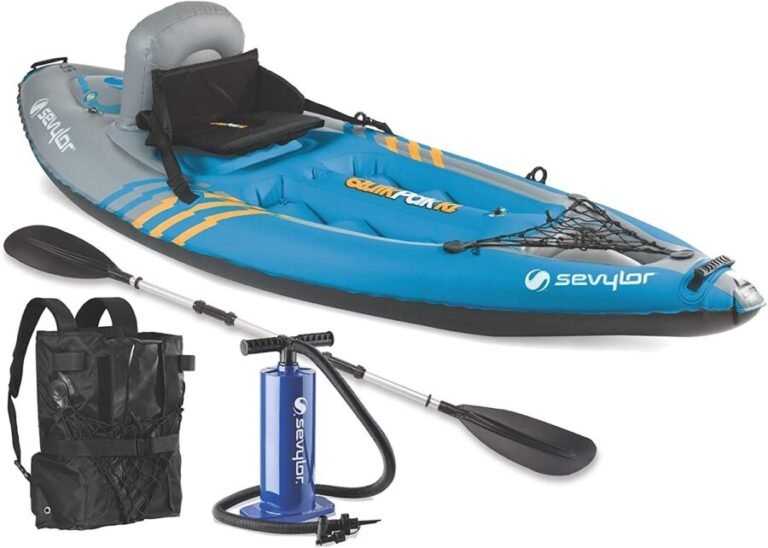How to Install a Fish Finder on a Kayak

When it comes to kayak fishing, having the right tools can make all the difference in your success on the water. One such tool that has gained popularity among anglers in recent years is the fish finder.
This compact device can significantly improve your fishing experience by providing real-time information about underwater terrain and the location of fish.
It uses sonar technology to send sound waves into the water, measuring the time it takes for the waves to bounce back. This information is then translated into a visual display, commonly known as a fish finder screen, showing the depth, structure, and presence of fish beneath the water’s surface.
Types of Fish Finders Suitable for Kayaks
- Portable Fish Finders: These are compact and easily mountable on a kayak. They often come with a portable transducer that can be attached to the kayak’s hull, offering flexibility during installation.
- Castable Fish Finders: these fish finders can be cast into the water from your kayak, providing real-time data to your smartphone or tablet. They are excellent for kayakers who value simplicity and mobility.
Key Features to Consider when Choosing a Fish Finder for Your Kayak
- Ensure the fish finder is water resistant, as kayaking inherently involves splashes and occasional wet conditions.
- Go for a fish finder that fits well within the limited space of a kayak without obstructing your movement.
- For kayakers who go on longer trips, select a fish finder with extended battery life. This is essential to avoid disruptions during your fishing trip.
- Choose a model with a user-friendly interface and intuitive controls, allowing you to focus on fishing rather than navigating complex settings.
Detailed Installation Guide
1. Gather Necessary Tools and Equipment
- Drill and Screwdriver: this is needed for creating mounting holes and securing the fish finder in place.
- Fish Finder Kit: Make sure you have all components, including the fish finder unit, transducer, cables, and mounting hardware.
- Marine Sealant: Use a high-quality marine sealant to prevent water from entering the kayak through mounting holes.
2. Choose a Good Location
Place the fish finder where it is easily visible and accessible while maintaining a clear line of sight. Choose a location that is less likely to be bumped or damaged during loading, unloading, or while out fishing on the water.
3. Mount the Transducer
- Inside the Hull Installation: For kayaks with a flat hull, consider mounting the transducer inside the hull using a water-soluble epoxy or marine sealant.
- Through-Hull Installation: In kayaks with a more pronounced keel, a through-hull installation may be preferable for optimal sonar performance.
4. Install the Fish Finder Unit
Use the drill and screws to securely attach the mounting bracket to the chosen location on your kayak. Once the bracket is in place, attach the fish finder unit securely, ensuring it is level and aligned for accurate readings.
5. Connect Power and Cables
Follow the manufacturer’s instructions to connect the fish finder to a power source, either through a dedicated battery or your kayak’s power system.
Use cable ties to secure the power and transducer cables along the kayak, preventing them from snagging or interfering with your fishing activities.
6. Test the System
Turn on the fish finder and ensure that it powers up without any issues. Verify that the fish finder displays accurate readings and responds appropriately to changes in depth.
Importance of Proper Fish Finder Installation
Installing a fish finder correctly is key to unlocking its full potential. Proper installation ensures accurate readings and reliable performance. Here are some reasons why it matters:
- Optimal Sonar Performance: Correct placement and alignment of the transducer guarantee accurate sonar readings, providing you with a clear picture of the underwater environment.
- Longevity of Equipment: A well-installed fish finder is less prone to damage, extending the lifespan of your equipment and maximizing its value over time.
- Prevention of Interference: Properly installed fish finders reduce the risk of signal interference, ensuring that you receive accurate information without disruptions.
Benefits of Using a Fish Finder on Your Kayak
- Real-time Information: Stay informed about underwater structures, water depth, and the presence of fish, giving you a strategic advantage in your fishing endeavors.
- More Accurate Navigation: Navigate through the water with confidence, avoiding obstacles and reaching your desired fishing spots more efficiently.
- Improved Fishing Efficiency: A fish finder helps you locate fish hotspots, enabling you to focus your efforts where they are most likely to yield the best results.
With the above, you should be all set to install your fish finder on your kayak. Ensure to test all systems before heading out.






